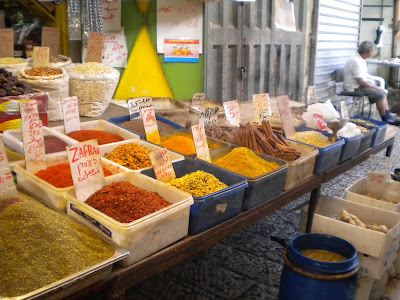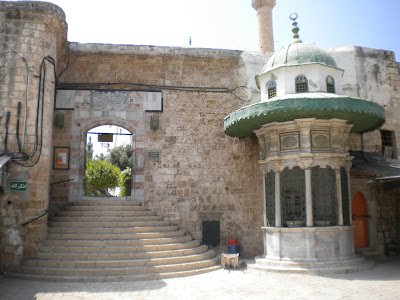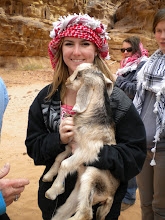 We drove several hours until we reached Acre (Acre in English, Akko in Hebrew, and Akka in Arabic), an ancient port city right on the Mediterranean. At work last week Imad, the director of the Palestine Wildlife Society, gave me a book to borrow called “Palestine: A Guide” by Mariam Shahun and it contains a ton of really interesting information. There are chapters devoted to both places we went to yesterday, Acre and Haifa, so a lot of the facts I will mention are from there.
We drove several hours until we reached Acre (Acre in English, Akko in Hebrew, and Akka in Arabic), an ancient port city right on the Mediterranean. At work last week Imad, the director of the Palestine Wildlife Society, gave me a book to borrow called “Palestine: A Guide” by Mariam Shahun and it contains a ton of really interesting information. There are chapters devoted to both places we went to yesterday, Acre and Haifa, so a lot of the facts I will mention are from there. After taking one wrong turn then backtracking to go the right way, we finally ended up in Acre. We were met in the parking lot by a man carrying around lobsters for sale that were the strangest looking lobsters I’ve ever seen in my life. The city is tropical and beautiful, with flat roads and lots of palm trees; it kind of reminded me of Florida.
 According to “Palestine: A Guide” evidence of the bay city was first recorded in the al-Amarna tablets of the 14th-century BCE. To the Greeks, Acre was Aka; to the Egyptians, Ptolemais, and to the Romans, Colonia Claudia Felix. Because of its strategic location right on the coast, Acre has been besieged, conquered, and the people killed or enslaved so many times it is almost unbelievable. It began as a Canaanite city and was subsequently captured by the Assyrians, the Greeks, the Romans, the Muslims, the Crusaders, the Ottomans, the British after WWI, and today it is part of the Jewish state. I read all about it in the book before going on our trip, so as you can imagine I was really excited to see such a historical place, and it did not disappoint me.
According to “Palestine: A Guide” evidence of the bay city was first recorded in the al-Amarna tablets of the 14th-century BCE. To the Greeks, Acre was Aka; to the Egyptians, Ptolemais, and to the Romans, Colonia Claudia Felix. Because of its strategic location right on the coast, Acre has been besieged, conquered, and the people killed or enslaved so many times it is almost unbelievable. It began as a Canaanite city and was subsequently captured by the Assyrians, the Greeks, the Romans, the Muslims, the Crusaders, the Ottomans, the British after WWI, and today it is part of the Jewish state. I read all about it in the book before going on our trip, so as you can imagine I was really excited to see such a historical place, and it did not disappoint me. 





After the Muslim conquest of Palestine in the late 600s, the Umayyad Caliph Mu’awiyah Ibn Sufian rennovated the harbor and built a serious fortification around it. One of his predecessors, Ahmad Ibn Tulun, continued his efforts and in the late 800s builders worked for 3 years to erect a thick stone wall around the city, most of which is still standing today. The wall is actually built IN the Mediterranean, as opposed to on land. It was a Crusader stronghold for a long time beginning in 1104, so there are both Christian and Muslims remnants throughout the city. On May 17th, 1948, the militant Jewish underground group Haganah wrested the city from its Arab inhabitants and expelled all but one quarter of the population, despite the fact that the UN partition had placed Akka in the Palestinian State. Today about a quarter of the city is still Arab, the remainder is populated by Israelis. Jiries and I walked on the cobblestone pathways and along the ancient wall, and it was absolutely fascinating to think about everything that had happened in that exact location over the centuries.














These signs were put up by particularly religious Muslims, and they call for people to attend mosque services, never to abandon Islam, and to pray all the time:


We went through the marketplace, which was narrow, somewhat crowded, nice-smelling (spice shops every few feet) and seemingly never ending. The shopkeepers were mostly Arabs selling souvenirs, knickknacks, and/or sweets for tourists and special things related to Ramadan for the locals. I’ve never seen so much stuff crammed into such a narrow pathway in my life. Despite the hectic atmosphere, the people were very friendly and it wasn’t unbearably crowded; it is somewhere I would definitely recommend going to visit if you get the chance (the city as a whole, but I mean if you are there check out the marketplace for an authentic-feeling experience). Despite the obvious signs of modernity, like hanging power lines or music-blaring light-blinking plastic toys for sale, it almost felt like I had gone back in time.






We also went into al-Jazzar Mosque, which was built in 1778 and named after the ruler of the time, Ahmad Pasha.
 It was built to legitimize him as a ruler through a religious endowment. Jiries says he can’t understand why the former ruler is revered today (his tomb site is considered sacred) because he killed so many of his own people; hence “al-Jazzar” means “the butcher”. Jiries said he is well known for the words of his first speech in front of the population that went to hear him speak: “I see rows of heads that are ripe for cutting.”
It was built to legitimize him as a ruler through a religious endowment. Jiries says he can’t understand why the former ruler is revered today (his tomb site is considered sacred) because he killed so many of his own people; hence “al-Jazzar” means “the butcher”. Jiries said he is well known for the words of his first speech in front of the population that went to hear him speak: “I see rows of heads that are ripe for cutting.” 




According to this book, on the second floor of the mosque there is a box stored that supposedly contains one hair from the Prophet Muhammad, and once a year it is shown to the faithful. Inside of the mosque compound is garden that, as it goes in Palestinian lore, was planted by the biblical Adam himself.
 I was wearing shorts and a t-shirt, which were appropriate for the hot day, but not so much for touring inside the mosque, so at the front entrance I was given two bed sheets to wrap around my legs and my shoulders. Besides a couple men praying and some lounging outside, there was no one else there. It was air conditioned inside the mosque so I wouldn’t have minded staying there all day, but we had big beach plans and we still had to visit Haifa so we left after just looking around.
I was wearing shorts and a t-shirt, which were appropriate for the hot day, but not so much for touring inside the mosque, so at the front entrance I was given two bed sheets to wrap around my legs and my shoulders. Besides a couple men praying and some lounging outside, there was no one else there. It was air conditioned inside the mosque so I wouldn’t have minded staying there all day, but we had big beach plans and we still had to visit Haifa so we left after just looking around. 



 Underground below all this is a large water cistern built by the Order of the Knights of St. John, which was established sometime in the 1200s.
Underground below all this is a large water cistern built by the Order of the Knights of St. John, which was established sometime in the 1200s.We only had to drive a couple minutes before we found a pretty amazing beach that you could park your car right on only a few feet away from your towel. At one point we tried to leave and realized the Tank, which is ridiculously heavy, was stuck in the sand. It took the help of about 5 very nice non-English speaking Israeli men and a large truck to dig the Tank out. Unfortunately, my camera was inside the car during all the mayhem so I did not get any pictures.
An umbrella that I am going to get for Jiries someday:








After the beach we drove about 20 minutes to the port city of Haifa. We traveled in the Tank to the top of Mount Carmel, which is a mountain in the middle of the city overlooking the bay. We admired the extravagant Bahai gardens from both the top and bottom of the mountain. Bahai is a monotheistic religion based on the teachings of the Persian Baha’u’llah, who is regarded by his followers as the most recent in the line of messengers of God. The religion has about 5 million adherents around the world. The gardens, which are maintained exclusively by Bahai followers, stretch from the bottom to the middle of the mountain where there is a shrine that contains the tomb of one of the religion’s founders.





At the base of the mountain we parked the car and walked around the Arab section of the town. Jiries said you can tell when you’re in the Arab section of town because there are watermelons for sale in the back of a pickup truck and shopkeepers are lounging on chairs outside of their stores.
 In 1948, four out of the six city quarters were Arab and included Muslims, Christian Arabs, Armenians, and Bahai Persians. The other quarters were Jewish and German. The UN partition designated Haifa as part of the Jewish state, but before the partition materialized in 1948 about 5,000 Jewish militia men surrounded the city, whose Arab neighborhoods were protected by only 500 Palestinians. Most of the residents fled to Lebanon, and out of Haifa’s 61,000 Arabs, only 3,500 remained. The rest were never allowed to return. Today the total population of Haifa is 300,000 and about 10% of the city is Arab; half are Muslims and the other half Christians. Some consider Arab-Jewish relations in Haifa to be more civil than elsewhere in the country; this may be true, but walking around the Arab section of town evidenced the deteriorated living conditions the people have no choice but to live in. As Arabs in a Jewish state, they are treated like second class citizens and denied basic things like building permits to maintain and restore their homes and stores.
In 1948, four out of the six city quarters were Arab and included Muslims, Christian Arabs, Armenians, and Bahai Persians. The other quarters were Jewish and German. The UN partition designated Haifa as part of the Jewish state, but before the partition materialized in 1948 about 5,000 Jewish militia men surrounded the city, whose Arab neighborhoods were protected by only 500 Palestinians. Most of the residents fled to Lebanon, and out of Haifa’s 61,000 Arabs, only 3,500 remained. The rest were never allowed to return. Today the total population of Haifa is 300,000 and about 10% of the city is Arab; half are Muslims and the other half Christians. Some consider Arab-Jewish relations in Haifa to be more civil than elsewhere in the country; this may be true, but walking around the Arab section of town evidenced the deteriorated living conditions the people have no choice but to live in. As Arabs in a Jewish state, they are treated like second class citizens and denied basic things like building permits to maintain and restore their homes and stores. 




Arab housing:

A bulletin board used to announce deaths in the village:






The new Israeli Haifa next to the old Arab Haifa

By the end of the day Jiries and I were both exhausted so we took turns driving and made it home by 10 pm. All in all, it was a great day and hopefully we have the chance to return there before I am stateside again.


No comments:
Post a Comment